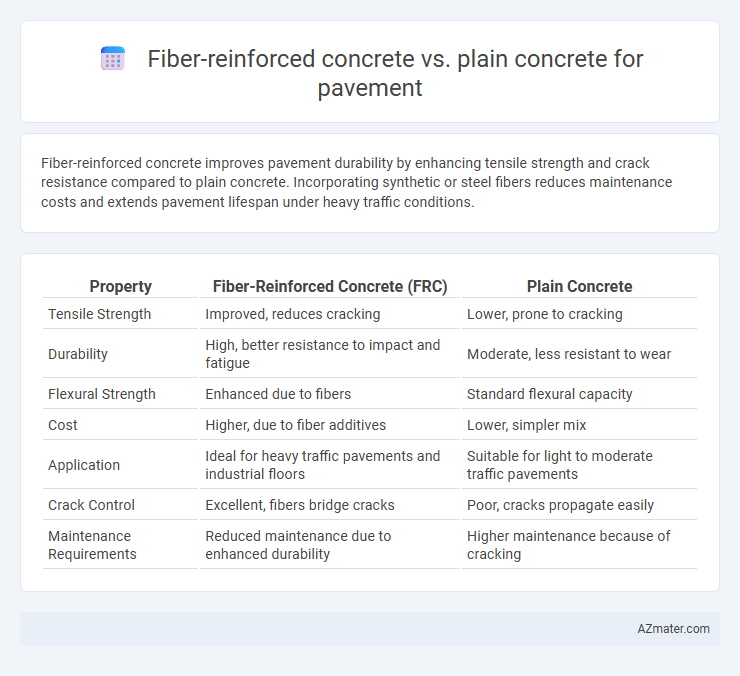Fiber-reinforced concrete improves pavement durability by enhancing tensile strength and crack resistance compared to plain concrete. Incorporating synthetic or steel fibers reduces maintenance costs and extends pavement lifespan under heavy traffic conditions.
Table of Comparison
| Property | Fiber-Reinforced Concrete (FRC) | Plain Concrete |
|---|---|---|
| Tensile Strength | Improved, reduces cracking | Lower, prone to cracking |
| Durability | High, better resistance to impact and fatigue | Moderate, less resistant to wear |
| Flexural Strength | Enhanced due to fibers | Standard flexural capacity |
| Cost | Higher, due to fiber additives | Lower, simpler mix |
| Application | Ideal for heavy traffic pavements and industrial floors | Suitable for light to moderate traffic pavements |
| Crack Control | Excellent, fibers bridge cracks | Poor, cracks propagate easily |
| Maintenance Requirements | Reduced maintenance due to enhanced durability | Higher maintenance because of cracking |
Introduction to Concrete Pavements
Fiber-reinforced concrete (FRC) significantly enhances the durability and crack resistance of concrete pavements compared to plain concrete, which relies solely on its inherent strength and traditional reinforcement methods. Including fibers such as steel, glass, or synthetic materials improves tensile strength, impact resistance, and fatigue performance, resulting in longer-lasting pavements that withstand heavy traffic loads and environmental stressors. Plain concrete pavements often require additional reinforcement and maintenance, whereas FRC offers a more resilient and low-maintenance solution for modern infrastructure demands.
Understanding Plain Concrete: Composition and Uses
Plain concrete, composed primarily of cement, water, and aggregates, offers strong compressive strength but lacks tensile reinforcement, making it suitable for rigid pavement structures where load distribution is critical. Its widespread use in pavement construction is attributed to its durability, cost-effectiveness, and ease of placement on highways, airport runways, and sidewalks. Despite its advantages, plain concrete's susceptibility to cracking under tensile stress limits its performance in high-traffic or flexible pavement applications.
What is Fiber-Reinforced Concrete?
Fiber-reinforced concrete (FRC) incorporates discrete fibers such as steel, glass, or synthetic materials to enhance tensile strength, toughness, and crack resistance compared to plain concrete. This composite material improves durability and reduces maintenance needs in pavement applications by mitigating shrinkage cracks and controlling crack propagation. The integration of fibers in concrete results in superior performance under heavy load and environmental stress, making FRC an effective solution for long-lasting pavements.
Key Performance Differences: Flexural and Tensile Strength
Fiber-reinforced concrete (FRC) significantly outperforms plain concrete in flexural and tensile strength, exhibiting up to 40% higher flexural strength due to the distribution of synthetic or steel fibers. These fibers effectively arrest micro-cracks and delay crack propagation, enhancing durability and load-bearing capacity under tensile stresses common in pavement applications. Plain concrete, while strong in compression, often lacks adequate tensile strength, leading to increased susceptibility to cracking and reduced service life in pavement structures.
Crack Resistance and Durability Comparison
Fiber-reinforced concrete (FRC) exhibits significantly enhanced crack resistance compared to plain concrete due to its ability to distribute stress and control micro-crack propagation. The incorporation of fibers such as steel, polypropylene, or glass improves durability by reducing shrinkage cracks and enhancing toughness under repetitive loading conditions typical in pavement applications. FRC pavements demonstrate longer service life and reduced maintenance costs, making them a more resilient choice for infrastructure exposed to heavy traffic and environmental stresses.
Installation and Construction Processes
Fiber-reinforced concrete improves pavement construction by reducing the need for steel reinforcement placement, accelerating installation times and minimizing labor costs. Its enhanced toughness and crack resistance allow for thinner pavement sections, simplifying formwork and curing processes compared to plain concrete. This results in faster construction cycles and increased durability, making fiber-reinforced concrete a preferred choice for demanding pavement applications.
Cost Analysis: Initial and Long-Term Expenses
Fiber-reinforced concrete (FRC) incurs higher initial costs due to the expense of synthetic or steel fibers mixed into the concrete, but these costs are often offset by reduced maintenance and longer service life compared to plain concrete. Plain concrete has lower upfront expenses but tends to require more frequent repairs and resurfacing, increasing long-term pavement lifecycle costs. Analyzing total cost of ownership reveals that FRC's enhanced durability and crack resistance contribute to significant savings in rehabilitation and downtime expenses over time.
Maintenance and Lifespan Considerations
Fiber-reinforced concrete (FRC) significantly enhances pavement durability by reducing crack propagation and improving resistance to fatigue and impact, leading to lower maintenance requirements compared to plain concrete. The inclusion of synthetic or steel fibers increases tensile strength and toughness, extending pavement lifespan by mitigating common deterioration mechanisms such as shrinkage cracks and freeze-thaw damage. Maintenance costs are typically reduced with FRC, as the material's improved structural integrity limits frequent repairs and surface patching associated with traditional plain concrete pavements.
Application Suitability: When to Choose Each Type
Fiber-reinforced concrete is highly suitable for pavements subjected to heavy traffic loads, impact forces, and potential cracking due to its enhanced tensile strength and crack resistance. Plain concrete is preferable for low-traffic, residential, or temporary pavements where cost efficiency and ease of placement take priority over high durability. Selecting fiber-reinforced concrete over plain concrete depends largely on the specific pavement load conditions and desired longevity.
Conclusion: Which Concrete is Best for Pavement?
Fiber-reinforced concrete outperforms plain concrete for pavement due to its enhanced durability, crack resistance, and load-bearing capacity, leading to longer service life and reduced maintenance costs. Its ability to distribute stress more evenly prevents early deterioration under heavy traffic and harsh environmental conditions. Investing in fiber-reinforced concrete ensures a more resilient, cost-effective pavement solution compared to traditional plain concrete.

Infographic: Fiber-reinforced concrete vs Plain concrete for Pavement
 azmater.com
azmater.com